
Bergamot: Planting, Growing and Caring
Contents
Bee balm in a nutshell
- Bergamot offers an original summer bloom in pink, mauve or white.
- It’s perfect for flower beds or natural gardens.
- Aromatic and medicinal, bergamot is also ideal for herb gardens.
- Easy to grow, it adapts to a wide variety of climates and soils.
- Its nectar-rich flowers attract pollinators and promote biodiversity.
Our expert's word
Bee Balm, or Monarda in Latin, is a lovely perennial that produces an abundance of ruffled, original and decorative flowers in summer. Among the best-known species is Monarda didyma, whose highly aromatic leaves were used for infusions by Native Americans, earning it the names “Oswego Tea” or “Red Bergamot”. Very popular, Red Bee Balm is also one of the varieties favoured by gardeners, but the different species and cultivars come in a wide range of colours, from white (M. ‘Schneewittchen’) to mauve (M. fistulosa menthifolia) and pink (M. ‘Croftway Pink’).
In addition to its charming, nectar-rich flowers, which are very popular with bees, Bee Balm also has the advantage of bearing highly aromatic foliage. Its fragrance blends mint and bergamot… hence its third name, “Bergamot Bee Balm”! It is highly prized for infusions as well as in cooking, where it enhances many dishes, sauces or drinks. Its medicinal properties, particularly antibacterial and digestive, are also used in herbal medicine.
In the garden, Bee Balm is easy to use. It suits many garden styles, adding colour and whimsy. It shines just as brightly at the edge of a vegetable garden, in a herb garden or in the mixed borders of an English garden. Natural and wild, it is simply perfect alongside grasses, Asters and Echinaceas in naturalistic-style gardens.

Bee Balm comes in a beautiful range of colours.
Hardy and low-maintenance, Bee Balm is an easy perennial that thrives in the sun and adapts to a wide range of soils. It only dislikes very poor soils (a spring compost addition will meet its needs), wet ground and confined spaces that encourage powdery mildew, the only mild disease it is known to suffer from.
Once established, this perennial spreads quickly, forming a large clump. Some may find it too vigorous, but rest assured: it’s quite easy to contain, just a few spade cuts will limit its expansion!
Description and botany
Botanical data
- Latin name Monarda
- Family Lamiacées
- Common name Monarde
- Flowering Estivale
- Height 0,40 à 1 m
- Exposure soleil ou mi-ombre
- Soil type fertile et frais
- Hardiness jusqu’à – 28° C
Bee balm is a herbaceous perennial native to the eastern United States. Hardy and undemanding, it has easily naturalised throughout North America.
Its upright stems, with the square cross-section typical of the Lamiaceae family, give it a bushy habit of 80cm to 1m tall. However, there are dwarf varieties, such as ‘Fireball’ bee balm, which don’t exceed 40cm in height.
Its deciduous foliage consists of leaves in varying shades of green, sometimes tinged with purple. Measuring 10 to 15cm long, they are lance-shaped and serrated, occasionally hairy on their underside. The veins are more or less prominent depending on the variety. Highly aromatic, bee balm leaves release a citrusy fragrance reminiscent of bergamot when crushed.
The striking, shaggy pom-pom-like flowers appear in summer, typically between July and September. The tubular flowers, which come in red, mauve, pink, lilac or white depending on the variety, are borne on purple, red or green bracts. Bee balm flowers consist of two lips: an upright upper lip and a more spreading lower lip divided into three lobes. Some varieties feature tiered flowers: a short stem rises from the centre of the first flower to bear a second, or even a third bloom.
The diversity of colours allows for varied uses and easy pairing with many other perennials, particularly in borders or flower beds. Its wild appearance also works wonders in informal gardens or wildflower meadows, and along stream banks provided the soil is well-drained. Highly attractive to pollinators, bee balm is valued in vegetable gardens and orchards for its ability to attract pollinating insects. Finally, this aromatic herb has its rightful place in any herb garden.
Very decorative, bee balm has excellent hardiness that allows it to withstand severe cold. However, its robustness goes hand in hand with its ability to spread via rhizomes. It can therefore become somewhat invasive, so its expansion should be controlled to prevent it from outcompeting neighbouring plants.
All parts of bee balm are edible (stems, leaves, flowers). Their flavour, a blend of bergamot and mint, is highly prized in cooking for enhancing salads, sauces, liqueurs… It’s also valued for infusions or to flavour tea.
Species and varieties
Undoubtedly, Monarda didyma is the most well-known species of the genus. Many cultivated varieties originate from it. It is also widely used for its medicinal properties, much like Monarda fistulosa, which has a more pronounced fragrance.
While most species are perennial, there are annual monardas such as Monarda citriodora, with its sweet lemony scent.
Although other species exist, it is the hybrid varieties that are most commonly sold, often without specifying the parent species.
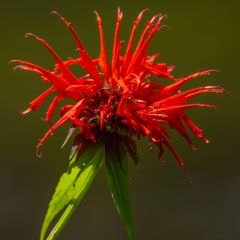
Monarda Fireball - Beebalm
- Blütezeit August to October
- Höhe bei Reife 40 cm
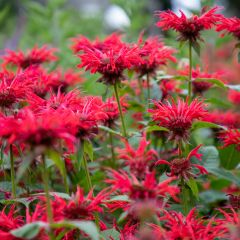
Monarda hybrida Gardenview Scarlet - Beebalm
- Blütezeit August to October
- Höhe bei Reife 80 cm

Monarda fistulosa Scorpion - Beebalm
- Blütezeit August to November
- Höhe bei Reife 90 cm
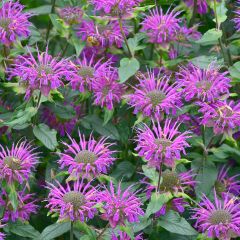
Monarda Prärienacht - Beebalm
- Blütezeit August to November
- Höhe bei Reife 90 cm
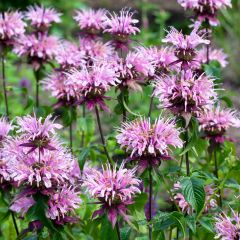
Monarda Beauty of Cobham - Beebalm
- Blütezeit August to October
- Höhe bei Reife 90 cm

Monarda didyma Cranberry Lace - Beebalm
- Blütezeit August to October
- Höhe bei Reife 30 cm

Monarda hybrida Schneewittchen - Beebalm
- Blütezeit August to October
- Höhe bei Reife 80 cm
Monarda citriodora subsp. austromontana Bees Favourite - seeds
- Blütezeit July to October
- Höhe bei Reife 90 cm
Planting Monarda
Where to plant?
Very hardy, bee balm is a perennial that adapts to a wide variety of climates and soils.
It thrives in sunny positions, but not scorching ones. In warmer regions, such as those in the south-east of France, provide it with light shade. In cooler climates, like the Jura or Massif Central for example, opt for maximum sunlight to fully enjoy its flowering.
It prefers soil rich in organic matter but remains moist. Avoid poor, dry soils where it would struggle to grow. Very hardy, it can however withstand severe cold. Be aware though, bee balm hates having wet feet, especially in winter, as well as overly heavy soils.
We recommend planting it in fertile, well-drained soil. In heavy, clayey, compact soil, prepare a drainage layer of gravel or pumice at planting time.
While drought and waterlogged soil are its enemies, it is fairly indifferent to soil pH, with a slight preference for neutral to acidic soils.
Resistant to pollution, bee balm settles effortlessly in urban gardens, lending them a rustic charm. Being rhizomatous, it can however become invasive when it finds a spot to its liking.
For minimal maintenance, take advantage of its wild nature to brighten up an inaccessible area or in a prairie-style garden. Bee balm also works wonders in borders or flower beds, either alone or mixed with other perennials, though you’ll need to keep its spread in check.
When to plant?
Bee balm can be planted in spring or autumn. However, we recommend spring planting, particularly in regions with very wet autumns, such as along the Channel coast.
How to plant?
To plant bee balm:
- Soak the root ball to moisten it before planting.
- Dig a hole two to three times the size of the root ball.
- Add a handful of well-rotted compost. In heavy, compact soil, place a layer of gravel or pumice at the bottom of the planting hole to improve drainage.
- Place the plant in the hole and backfill. Ensure the plant is positioned so the crown (where the roots meet the stem) is level with the soil surface.
- Firm gently and water immediately.
- Apply a mulch around the base to retain moisture.
For borders or flower beds, allow about 4 pots/m². Space plants at least 40cm apart in all directions to ensure optimal growth and allow air circulation.
Container planting is certainly possible, as with most perennials, though this isn’t the preferred cultivation method for bee balm.
Maintenance
Under good growing conditions, bee balm is a low-maintenance plant that requires little care.
However, it is a hungry plant. We recommend adding well-rotted compost each spring, especially if your soil is poor. This helps stimulate growth during this period of regrowth.
Water regularly in spring and summer – the soil should never dry out completely. Then mulch carefully around the base to retain moisture. Dry soil hinders the plant’s proper development.
To encourage and prolong flowering, remove spent blooms as they appear. This will promote new flower production.
In autumn or late winter, cut back the clump to ground level once the leaves and flowers have completely dried.

Bee balm flowers remain decorative even when spent – you may choose to cut them back only in late winter.
When bee balm thrives, it tends to spread via underground runners, colonising space and competing with neighbouring plants. Remove new shoots as they appear if you wish to control its spread.
Note: Too shady a position or excessive humidity encourages powdery mildew.
Diseases and Pests
Bee balm is a perennial susceptible to powdery mildew. This disease, also known as white mould, is recognisable by the appearance of a white, powdery coating on the leaves, which quickly spreads to the undersides and then the entire plant. The causes of powdery mildew can be numerous: overly dense planting, significant temperature fluctuations between day and night, excessive humidity, prolonged drought…
As is often the case with plant diseases, prevention is the best remedy! To avoid powdery mildew, we recommend spacing your plants well when planting (40 cm is the minimum for proper air circulation) and watering at the base during dry spells, taking care not to wet the foliage.
If these measures prove insufficient, act at the first sign of symptoms to prevent the disease from spreading. Remove affected parts and spray with nettle manure to strengthen the plant. Remember to thoroughly disinfect your pruning tools!
Note that powdery mildew-resistant varieties have been developed, such as Bee Balm ‘Gardenview Scarlet’.
Regarding pests, the aromatic foliage of bee balm tends to repel harmful insects, hence its recommended use in vegetable gardens! However, watch out for slugs, which are fond of young shoots in spring. While often mentioned, beer traps are not advisable. Although beer does attract slugs away from your plants, it’s so effective that it tends to draw in all the slugs from the neighbourhood! To avoid an invasion, use a slug repellent like Ferramol, which is suitable for organic gardening. You could also try spraying a garlic decoction, an excellent slug deterrent.
Propagation of Monarda
Monarda can be propagated by division, sowing or cuttings. However, we recommend opting for clump division, which is much simpler to carry out and almost guaranteed to succeed.
Division
Monarda is a rhizomatous perennial plant that produces many peripheral shoots. After a few years, the plant tends to weaken and become bare in the centre. To help it regain its full vigour, we recommend dividing it every 3-4 years.
In spring (March-April), or in autumn (September-early October) for drought-prone regions:
- Dig up the clump using a sharp spade.
- Separate it into several sections, ensuring each has sufficient roots.
- Replant each section immediately and water.
Keep the soil moist in the following weeks.
Sowing
Sowing is done in spring, between April and June, using seeds from shops or from dried flowers.
- Sow thinly in a seed tray using a “seed compost”.
- Water lightly, without saturating the substrate.
- Transplant at the 4-5 leaf stage into individual pots.
- Wait until early autumn to plant them in their final position.
Direct sowing is also possible from May onwards. Sow lightly (the seeds are very fine) and remember to thin out your seedlings as they grow.
Be aware that Monarda varieties hybridise easily with each other, so seeds collected from the garden may produce plants with different characteristics from the parent plant!
Cuttings
Cuttings are taken in spring, between May and June, before the Monarda flowers. Unlike sowing, this method preserves the characteristics of the parent plant, but it is less common than division. This method is indeed much slower.
- Take a young shoot about ten centimetres long.
- Keep only the leaves from the upper part.
- Plant the cutting in a pot filled with compost and firm lightly.
- Place the cutting in a bright spot, but out of direct sunlight.
Keep the substrate moist until new growth appears, then grow in a pot until the following spring, the ideal time for planting Monarda.
Associations
To create a vibrant flower bed, don’t hesitate to play with contrasting colours and shapes by combining a red-flowered monarda, such as Monarda ‘Gardenview Scarlet’, with other yellow and orange perennials like rudbeckias or helianthus.
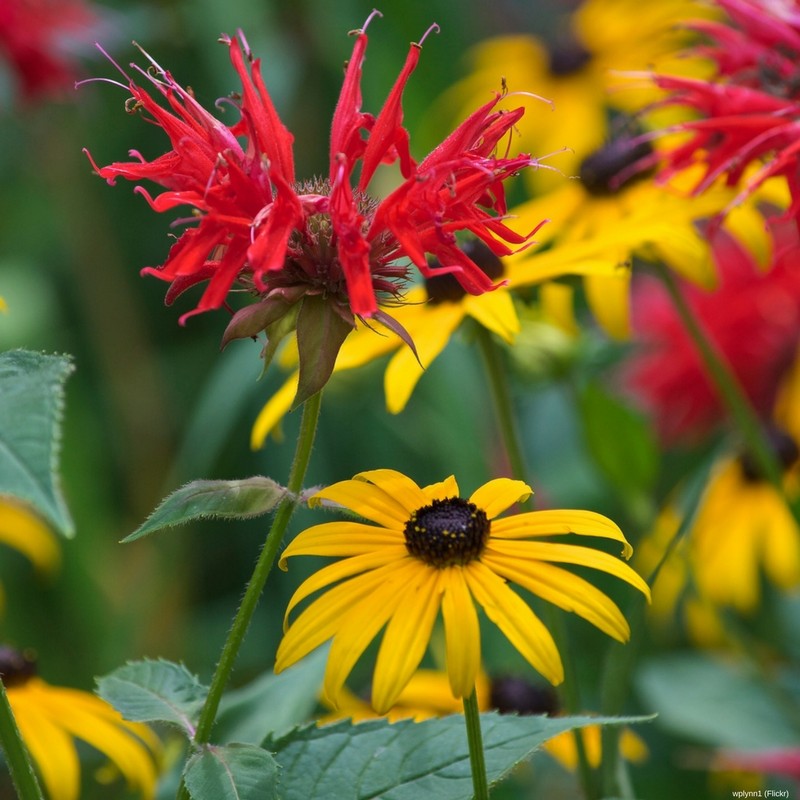

An idea for a contrasting combination: Monarda ‘Gardenview Scarlet’ and Rudbeckia fulgida ‘Goldsturm’.
If you prefer romantic settings, opt for pastel shades by pairing the soft pale pink of Monarda ‘Beauty of Cobham’ with the delicate blue of echinops and the mauve of agapanthus. The milky flowers of Campanula lactiflora ‘Alba’ will also work wonders in this setting.
In a mixed border, place tall perennials in the background, such as delphiniums and Rudbeckia maxima. Position your monarda plants in the middle, alternating with other perennials of varying heights to avoid monotony. Feel free to add an ornamental grass like Pennisetum, whose silky plumes will bring movement to your composition. Finally, in the foreground, opt for ground-cover plants, alternating green foliage with coloured leaves. Heucheras and ipomoeas, for example, offer a wide variety of colours and forms.
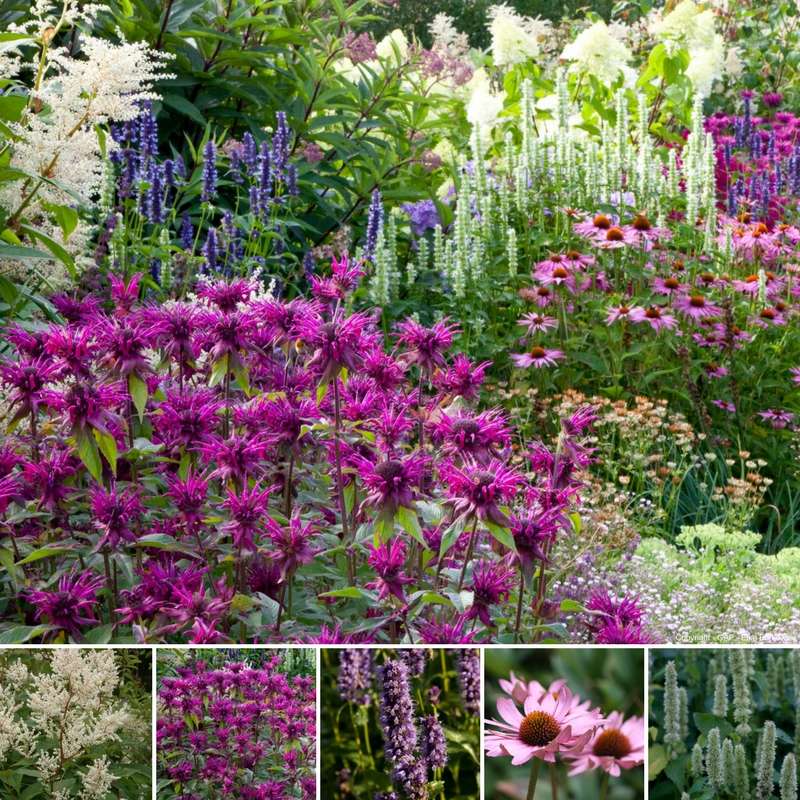

An example of a lush mixed border combination: Monarda ‘Scorpion’, Persicaria polymorpha, Echinacea purpurea, Agastache ‘Black Adder’, Agastache rugosa ‘Alabaster’.
For a more natural and rustic look, such as in a wildflower meadow, embrace the slightly wild appearance of Monarda citriodora ‘Bees Favorite’ with its tiered flowers. Pair it with Oriental poppies, with their large, crinkled silk-like petals, or airy Nigella damascena with its star-shaped flowers. Daisies and cornflowers are also excellent choices for this style.

A beautiful example of a natural combination: Monarda ‘Scorpion’, Deschampsia cespitosa, Veronicastrum virginicum ‘Fascination’, Euphorbia waldsteinii ‘Betten’, Filipendula palmata.
Both aromatic and medicinal, monarda has its rightful place in a herb garden (or cottage garden). Plant Monarda fistulosa and Monarda citriodora alongside other herbs like lavender, Roman chamomile, hyssop, or perennial savory. The choices are endless! To enjoy its fragrance with every stroll, planting along pathways is also an excellent option.
Finally, to take full advantage of its pollinator-friendly nature, place monarda along the edges of your vegetable garden. The icing on the cake—its scent tends to repel pest insects!
Did you know?
Bergamot has several nicknames including “red tea”, “Oswego tea” or “Indian tea”. Far from being random, these names stem from one of the major events of the American Revolution, the famous “Boston Tea Party”.
In the 18th century, the British crown held 13 American colonies. The colonists, heavily taxed, eventually rebelled. The tea shipments bore the brunt of this and were thrown into the sea. And bergamot infusion took advantage of this to become the fashionable drink!
The colonists simply adopted the traditional recipe of the Oswego Indians (present-day New York), who had used bergamot in infusions for centuries for its medicinal properties. The success was immediate, even crossing the Atlantic, and in the process gave bergamot its names of “red tea”, “Oswego tea” or “Indian tea”.
Useful resources
Discover our wide range of bee balms!
An article by Ingrid on our blog, to help you create a successful flower bed.
Frequently asked questions
-
My bee balm isn't thriving and seems to be struggling. What should I do?
A soil too poor in organic matter hinders the growth of bee balm. Add well-rotted compost each spring to restore its vigour. Lack of water or very heavy soil can have the same detrimental effects.
-
My young bee balm plants have disappeared!
Be careful, slugs are fond of new shoots! Stay vigilant in the weeks following planting and set up barriers of ash or coffee grounds. Remember to repeat the process after each rainfall. You can also use a slug repellent such as Ferramol, to be applied at planting time.
-
My bee balm is thinning out at the centre. Why is this happening and what should I do?
Like mint, bergamot often ages poorly and needs dividing every 3 to 4 years. Indeed, this perennial spreads via underground rhizomes, which weakens the centre of the clump. Divide it in spring by separating the clump into sections with a sharp spade. Replant immediately and water well.
- Subscribe!
- Contents


































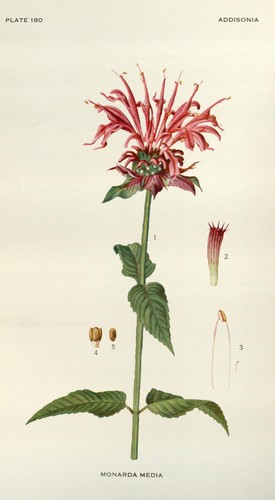
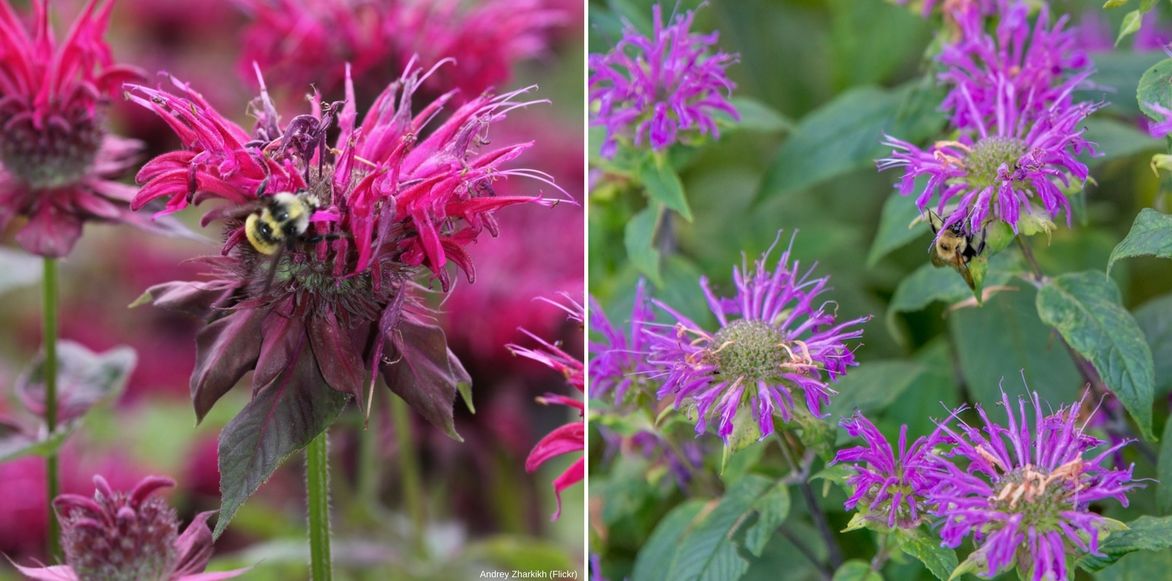
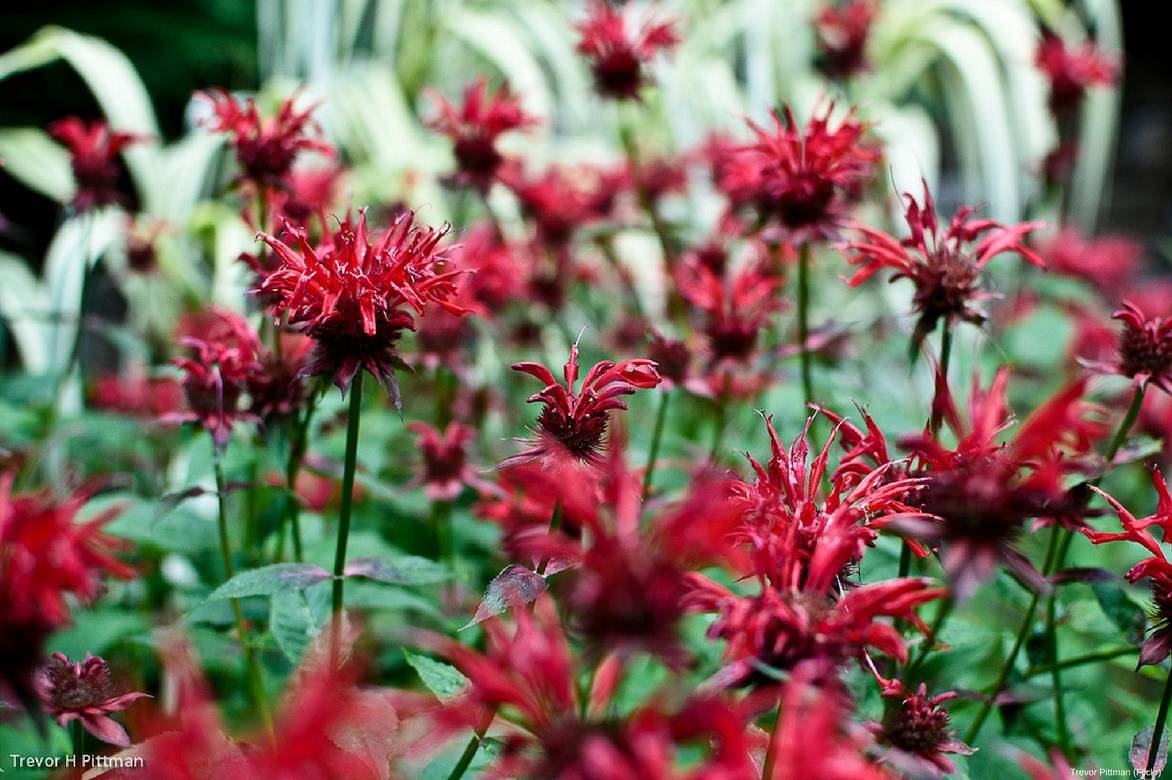
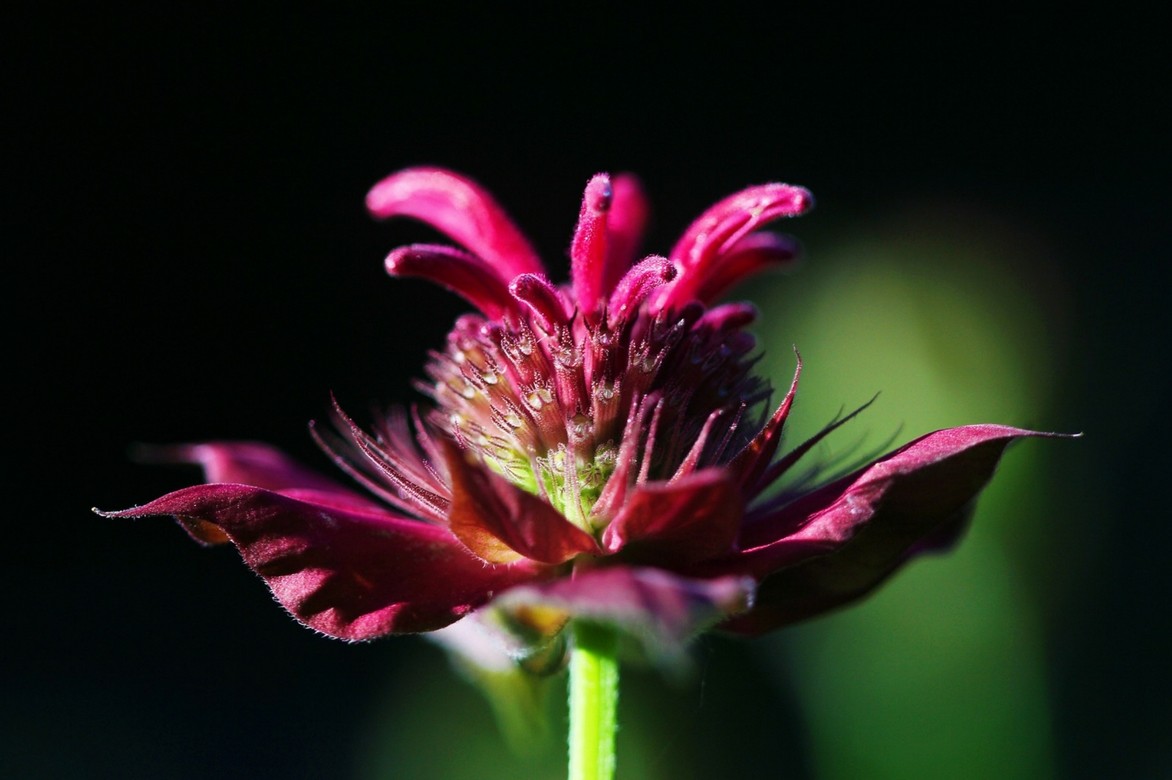
Comments